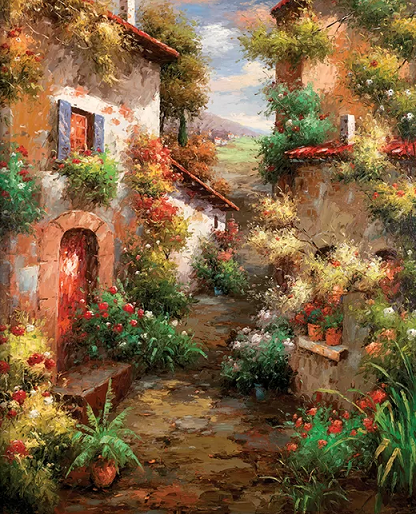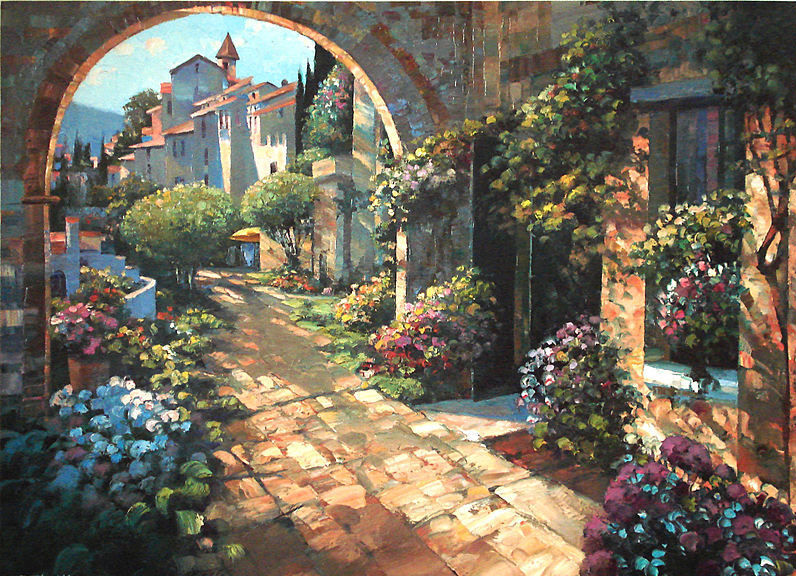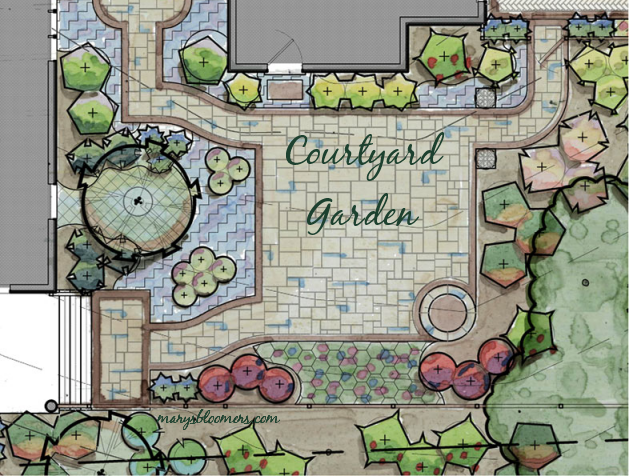 |
| When i think of Mediterranean
gardens, I picture the garden styles of Greece. I picture
the stone walkways, terraces and homes, and clay pots filled to
over-flowing with flowers and herbs everywhere you can place one. There
are famous formal Greek gardens, very classical style. I prefer the more
welcoming, and less needy informal gardens, seen in most towns and
villages. I'm not a fan of columns and stone fountains. I like
laid-back. Tuscan gardens are lovely, too. They're designed to be
completely Italian. Greek gardens contain more elements from several
Mediterranean regions. Both styles make heavy use of hardscaping with
gravels and stone, and often with colorful tiles.
Clay pots are a big feature of Mediterranean gardens. I favor clay pots because they have old world charm, but they look great with a modernistic or Japanese stylet plant in them, but they're a problem here in the cold northeast U.S because of the probability of cracking over winter if you're planting shrubs and trees in them. And once they are filled, they are very heavy. I wrap my pots from the bottom up, with burlap stuffed with leaves for winter and make sure there are big drainage holes to prevent cracking. I picture a few small fruit trees in those pots in a Mediterranean garden, arranged on narrow stone patio areas or a layered outcropping of rocks. Pots galore were on steps, on stone ledges and sills, on every flat surface. The gardens in Greece don't seem to have a lot of soil as the base of the gardens, but lots of clay pots. Which are pretty awesome in hot dry areas because they absorb water and help the plants during dry spells. Here's a pretty garden design for a container garden that would look perfect in a Mediterranean style garden. I would duplicate it 2 or 3 times as an accent row in the garden, and use the same or different plants with that look. It looks awesome lined up in that configuration, with a small space with gravel or large pot with a dwarf citrus tree in-between the groupings along paths, walkways, or against fences. Use as many groupings as you need for the size of your space.. In terms of cost - i have found some beautiful, extra large urn and square tub planters that look just like stone, but are made of a weather-resistant resin or stone-like material. My gardens are full of large containers. I just wait for a sale and stock up. After all, i will always be designing, re-designing and planting something. If you'd like to keep this garden design, just click the pic and download it in .pdf format. Here
are a few more designs that would do well in a Mediterranean Garden
landscape. You can plan and grow a Mediterranean style garden by remembering what will create the look, based on the climate the gardens actually grow in. Reproducing the look is based on that climate and culture. Plant substitutions are tricky, but there are many ways to get that bight-colored and sun-baked feel. Easier, of course, if you live in a hot and dry planting zone. I would use my xeriscaping and container gardening skills to work to deal with the heat and less areas of soil to plant in. I would make heavy use of stone and gravel. Mostly in white and pale beiges. White is used to bounce the hot sunshine away from you and your garden. And white stone looks clean and bright . Which i believe is the atmosphere I would require. I would stay away from too much of a desert look, which would confuse the garden with southwestern or cactus gardens.
Pergolas and Arches
- covered in vines
like grapes, trumpet flowers, honeysuckle, and other brightly colored flowers.
Stone Planters and Vases - Those seem to be the focal points of every Mediterranean garden design i've seen. Container gardening seems to be a huge part of a Mediterranean Garden. But I love containers anyway. A 3-pot grouping here and there on white gravel or stone bases pleases my eye. One very large pot containing a lemon or fig tree, between two smaller pots filled with scented herbs and flowering plants. That's me. Also me, is lining up large clay pots or urns along a walkway under multiple pergolas growing grapevines. White pea gravel is awesome as a base, with larger white stones as stepping stones, ledges or accents. Clay pots are preferred over plastic or resin. Plastic pots let in heat and keep it there. Stone and clay pots cool by evaporation. Since i don't live in a dry, hot region, the faux stone pots are pretty and can fake the real ones. And be moved around way more easily than stone. If you live in a dry and hot area, you may want to put saucers under pots to hold water that the plants will drink when they need it. Pebbles and cobblestones look beautiful wherever you use them.
Plants In The Pots - In the dry heat of the Mediterranean summer, pots of succulents and heat/drought tolerant plants would be glorious. I am growing several low-growing varieties now, and have found some perennial succulents that would work beautifully in the design. "Colour Guard" Yucca is my favorite. It can grow to 3 ft. tall and wide. It makes a bold statement. Bright green and yellow sword-shaped leaves stands out in a large planter or in-ground with smaller plants at the base. There are several ornamental grasses and Agaves that come to mind, as well. No cactus. I would draw the fine line on designing a xeriscape that says desert or Southwest, when i want mostly lush and fragrant foliage and flowers for warm weather garden design. Mediterranean gardens feature pots filled with easy plants such as rosemary, lavender, salvias, and thyme. I think any fragrant herb would do. Greek and Italian cooking requires a lot of oregano, so that would be grown in my garden. It may not be a feature of Mediterranean gardens, but I would still add a cedar raised garden bed or beds against walls or fences - paint them white to blend with the light/bright color schemes. Those are great for growing herbs or with a specimen plant like Yucca in the center, with low-growing herbs all around it. There's room at the bottom, between the legs or in front of it, for clay pots with flowers.
There should be several brightly colored
flowering plants and evergreens. Native Plants with bright colors
- would
also look great in your Mediterranean Garden. My suggestions for flowers
would be Sun Roses, which are low-water groundcover types. The foliage,
in greys and greens, looks great mixed in with the herbs and succulents,
and they bloom like crazy. Spurge because their foliage colors range
from blue-green to medium green, and their flowers add lime green
and orange-red, Add the groundcover type to the base of plants in pots
or under taller plants in raised beds and window boxes..and Wallflowers
for fragrance. They grow quickly to 2-3 feet around, and bloom
prolifically even in their first season. Choose hot reds, oranges and
yellows. Download A Courtyard Garden Plan by
Southern Living
Water features are prevalent in larger Mediterranean gardens because of the heat and dryness of summer. It looks and feels refreshing, and it's awesome when outfitted with solar fountains to bubble or spray. The sight and sound of moving water is awesome at night, too. Hanging solar jar lights on limbs or from a pergola would add a romantic touch. I wouldn't use path lights because they just don't fit the Mediterranean garden look. But i would hang small, warm white (run away from the irritating blue-white) solar lights on the pergolas and trees. In all garden lighting projects, the toned-down look of warm white lights evokes a more subtle and serene atmosphere than the bright white. I use them as general lighting on trees, but i wouldn't use them in private seating nooks. My personal preference is not to use formality at all in my gardens, so containers and small informal water features spread out would be my plan, rather than the huge white stone cascading fountain as the focal point. It's a beautiful look, but it's not me. Trees - I like to plant dwarf trees in big pots... and add a dense trailing variegated groundcover succulent at the base. If your USDA cold hardiness zone allows for it, grow small varieties of these citrus trees: lemons, limes, oranges, tangerines. You can still grow these if you have a place indoors to keep them over winter. A fig tree would be the awesome tree i plant first. If you live in a cooler summer region, there are good tall and slender evergreen varieties to plant in big pots: ‘Skyrocket’ Juniper, ‘Emerald’ Thuja occidentalis and "Sky Pencil" Holly are some. I've grown them all at sometime or other. Evergreens and ornamental grasses that grow in globe or ball shapes look terrific as well. I choose "Elijah Blue" festucca grass. Evergreen, a bluish green, grows about a foot tall, and I like the taller Blue Rush (needs watering) for almost any garden. It grows in a fan shape, and does well in water or in soil.
photo of an Italian style Mediterranean Garden from homeyou.
Quick Links Content, graphics,
photos and design ©2020 marysbloomers.com |












